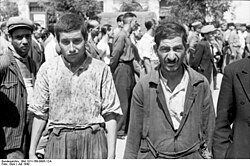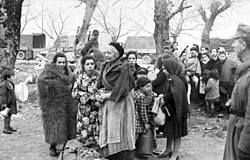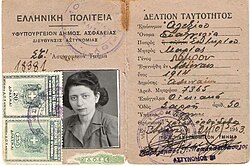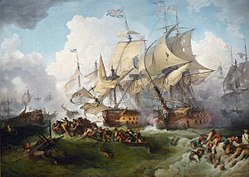Adolf Eichmann, 1942
SS-Obersturmbannführer Adolf Eichmann (1906–1962), head of Reichssicherheitshauptamt (RSHA, Reich Security Central Office) Department IV B4 (Jewish affairs), who organized the deportation of Jews to the Auschwitz concentration camp in German-occupied Poland during the Holocaust. Taken in or around 1942, this appears to have been Eichmann's official RSHA ID photograph. Yad Vashem describes the image as "Eichmann, RSHA (Reich Central Security Office), 1942, Collection Archive, Yad Vashem Archives." See this version with a signature; the holes from the hole punch are visible.
The image shows Eichmann in his Obersturmbannführer (lieutenant colonel) uniform, with four silver pips and a stripe on the left collar. He became Obersturmbannführer on 9 November 1941.[1]
David Cesarani writes: "The much used official photograph of the smiling young SS officer with filmstar looks who deported millions of Jews to the death camps seems to personify all the perpetrators of Nazi genocide. The ubiquity of this image is equalled by that of Eichmann at his trial in Jerusalem in 1961, sitting or standing inside a bulletproof glass booth".[2]
It is not known where the photograph was taken. After the Wannsee Conference in January 1942, Eichmann travelled extensively, setting up offices in countries from which Jews were being deported. The birth of his children mirrored this movement: his first son was born in Berlin, Germany, in 1936; his second in Vienna, Austria, in 1940; and his third in Prague, Czechoslovakia (now the Czech Republic), in 1942, where he and his wife had rented a home since 1939 and which he regarded as his official residence. He would regularly return to Berlin.[3] (His fourth son was born in Buenos Aires, Argentina, in 1955.)
Bettina Stangneth writes that, from June 1942, when Reinhard Heydrich, head of the RSHA, was assassinated in Prague, Eichmann "began ensuring that no one took his photograph".[4] Describing the security measures Eichmann took because he "lived in constant fear of assassination", Dieter Wisliceny, another SS officer, wrote in a statement in 1946: "The same caution made him camera-shy. Whenever he needed photographs for identification papers, he had them done by the Gestapo Photographic Laboratory. I myself took two pictures of Eichmann, the first in 1937 and the second in 1944, showing Eichmann in uniform. It was taken in Hungary, and even there Eichmann made me give him the negative. The pictures used to be in my apartment in Vienna 18, Buchleitengasse 8."[5]Because this is an official image, it can be regarded as having been published in the form of an ID document at the time. It is in the public domain in the US because it was published between 1923 and 1977 without compliance with US formalities. If it was part of Eichmann's RSHA personnel file, it would have been seized by the Alien Property Custodian as enemy property. Ladislas Farago wrote in 1974 that passport-size Eichmann photographs were held by the Allies after the war, "including in the captured archives of the RSHA, the SS main office, and on file at Nuremberg, numbered No. 2259."[6] The image can also be regarded as the work of a criminal enterprise (the SS). For the Commons status of other images associated with the SS, see:
- Category:Auschwitz Album
- Commons:Deletion requests/File:Selection Birkenau ramp.jpg
- Commons:Village pump/Archive/2015/02#Auschwitz Album
- Commons:Village pump/Copyright/Archive/2015/02#URAA on WWII photos of Nazi extermination camps
Also see "17 U.S. Code § 104A - Copyright in restored works", Legal Information Institute; "Captured German Records and the Berlin Document Center" and Eichmann file, National Archives.
References
- ↑ For the date, see Leni Yahil, The Holocaust: The Fate of European Jewry, 1932–1945, Oxford University Press, 1990 [1987], p. 315.
- ↑ David Cesarani, Becoming Eichmann, Da Capo Press, 2007, p. 1.
- ↑ a b Bettina Stangneth, "Otto Adolf Eichmann", in Hans-Christian Jasch and Christoph Kreutzmüller (eds.), The Participants: The Men of the Wannsee Conference, Berghahn Books, 2017, pp. 52–53.
- ↑ Bettina Stangneth, Eichmann Before Jerusalem, Vintage, 2015, p. 39.
- ↑ Tuviah Friedman, The Hunter: Autobiography Of The Man Who Spent Fifteen Years Searching For Adolf Eichmann, Normanby Press, p. 262.
- ↑ Ladislas Farago, Aftermath: Martin Bormann and the Fourth Reich, Hodder & Stoughton Ltd, p. 291.
Relevante Bilder










































Relevante Artikel
Adolf EichmannOtto Adolf Eichmann war ein deutscher SS-Obersturmbannführer. Während der Zeit des Nationalsozialismus und des Zweiten Weltkrieges leitete er in Berlin das „Eichmannreferat“. Diese zentrale Dienststelle des Reichssicherheitshauptamtes organisierte die Verfolgung, Vertreibung und Deportation von Juden und war mitverantwortlich für die Ermordung von schätzungsweise sechs Millionen Menschen im weitgehend vom NS-Staat besetzten Europa. Im Mai 1960 wurde er von israelischen Agenten aus Argentinien entführt und nach Israel gebracht, wo ihm ein öffentlicher Prozess gemacht wurde. Er wurde zum Tode verurteilt und in der Nacht vom 31. Mai auf den 1. Juni 1962 durch Hängen hingerichtet. .. weiterlesen
Holocaust in GriechenlandIm Holocaust in Griechenland wurde im Zweiten Weltkrieg von den Besatzungsmächten Deutschland und Bulgarien zwischen 1943 und 1944 nach Ghettoisierung, Zwangsarbeit und Enteignung die jüdische Bevölkerung Griechenlands beinahe vollständig in deutsche Konzentrationslager deportiert und dort vernichtet. Zumindest 58.885 Juden, davon mehr als 46.000 aus Thessaloniki, wurden überwiegend in den Gaskammern der Vernichtungslager Auschwitz und Treblinka ermordet. .. weiterlesen
1. JuniDer 1. Juni ist der 152. Tag des gregorianischen Kalenders, somit verbleiben noch 213 Tage bis zum Jahresende. .. weiterlesen
